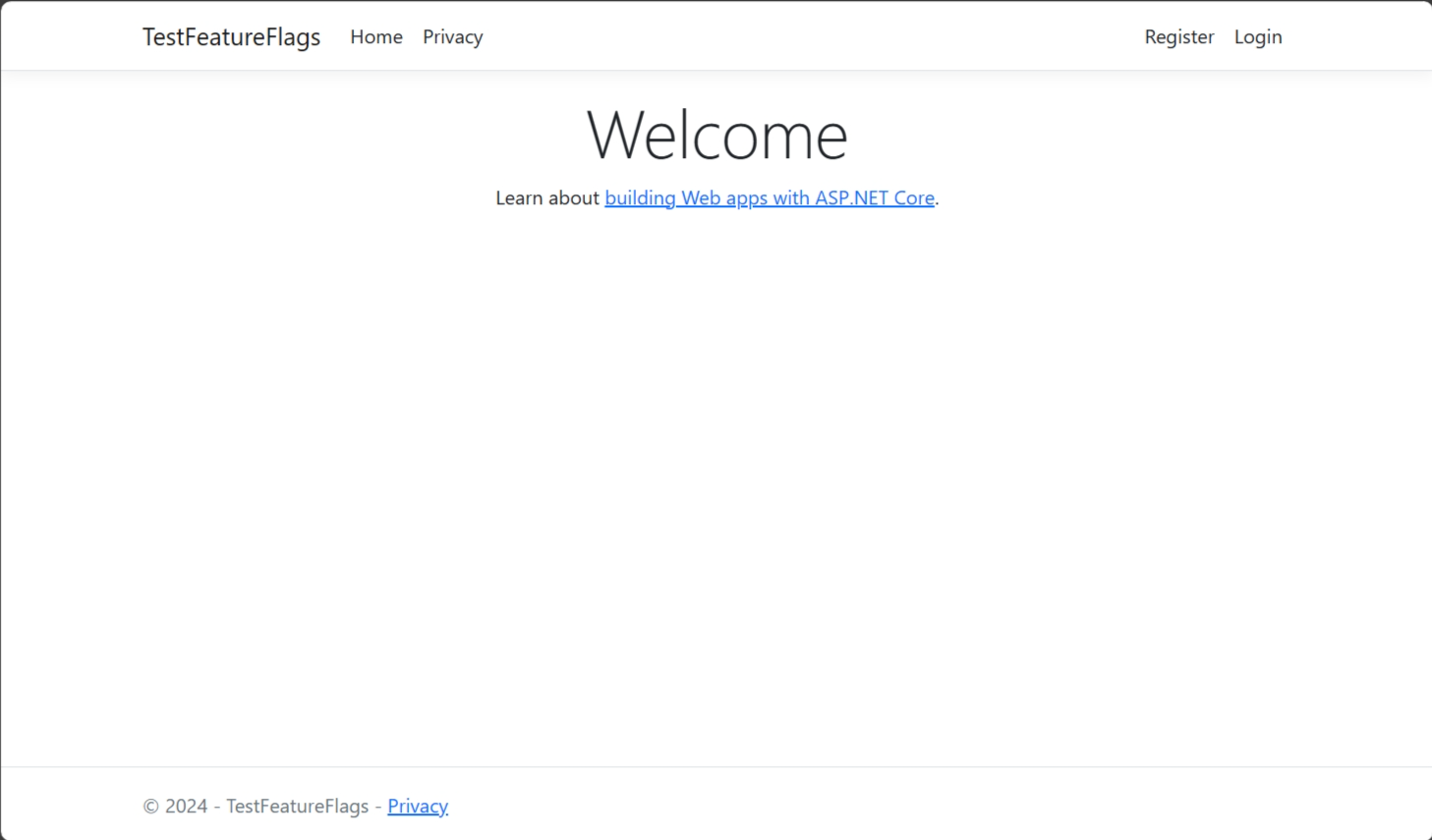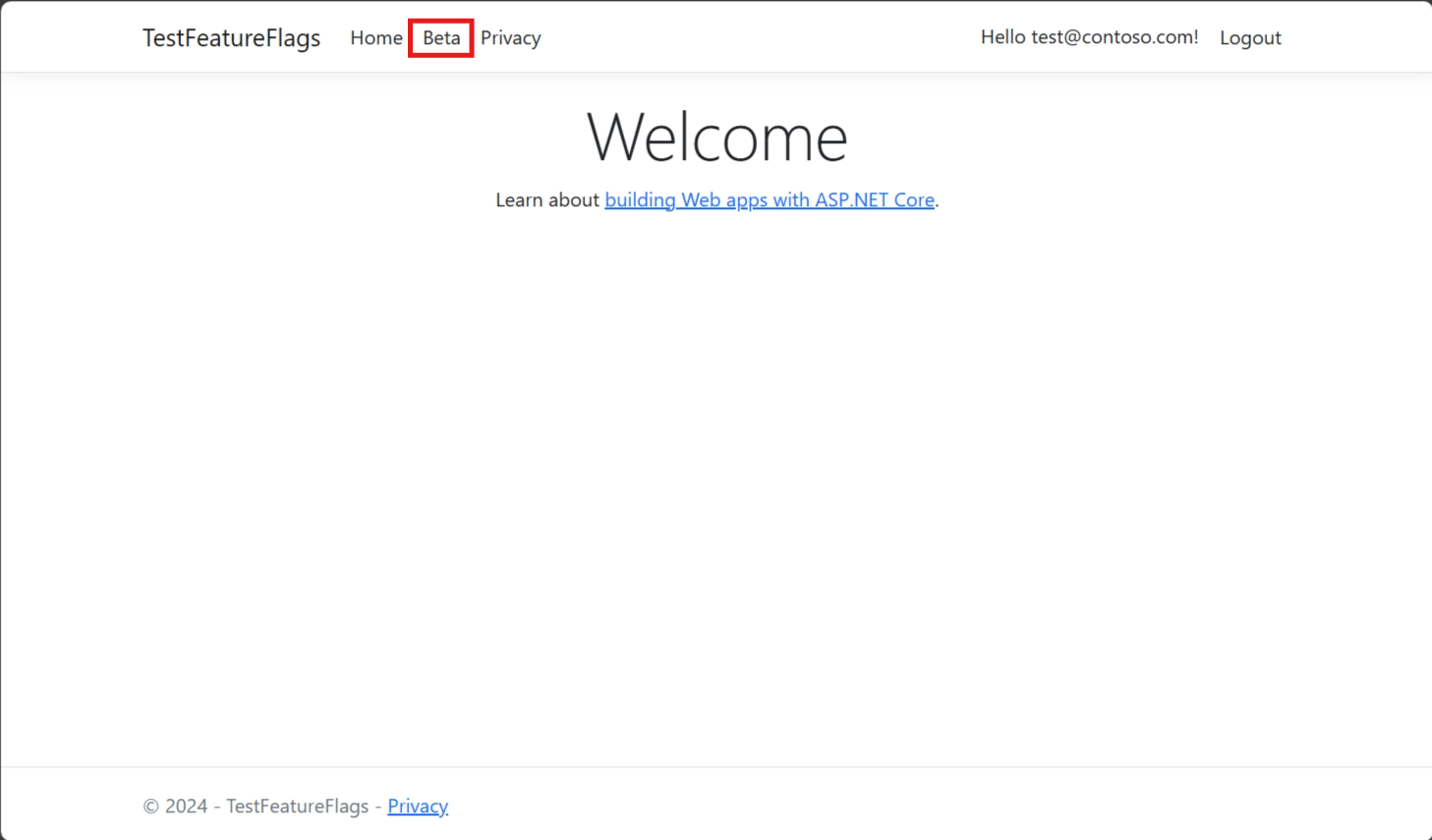將功能推出至 ASP.NET Core 應用程式中的目標物件
在本指南中,您將使用目標篩選將功能推出至 ASP.NET Core 應用程式的目標物件。 如需目標篩選的詳細資訊,請參閱向目標受眾推出功能。
必要條件
- 具有有效訂用帳戶的 Azure 帳戶。 免費建立一個。
- 應用程式組態存放區。 建立存放區。
- 具有目標篩選的功能旗標。 建立功能旗標。
- .NET SDK 6.0 或更新版本。
使用功能旗標建立 Web 應用程式
在本節中,您會建立 Web 應用程式,讓用戶能夠登入並使用您之前建立的 Beta 功能旗標。
使用下列命令建立 Web 應用程式,以針對本地資料庫進行驗證。
dotnet new webapp --auth Individual -o TestFeatureFlags流覽至新建立 的 TestFeatureFlags 目錄,並新增下列 NuGet 套件的參考。
dotnet add package Microsoft.Azure.AppConfiguration.AspNetCore dotnet add package Microsoft.FeatureManagement.AspNetCore dotnet add package Azure.Identity執行下列命令,為應用程式建立用戶密碼。
此命令會使用秘密管理員來儲存名為
Endpoints:AppConfiguration的秘密,其會儲存您 應用程式組態 存放區的端點。 將<your-App-Configuration-endpoint>佔位元取代為您的 應用程式組態 市集端點。 您可以在 應用程式組態 市集的 [概觀] 刀鋒視窗中,於 Azure 入口網站 中找到端點。dotnet user-secrets init dotnet user-secrets set Endpoints:AppConfiguration "<your-App-Configuration-endpoint>"將 Azure 應用程式組態和功能管理新增至您的應用程式。
您可以使用
DefaultAzureCredential來向 應用程式組態 存放區進行驗證。 請遵循指示,將認證指派給 應用程式組態 數據讀取者角色。 在執行應用程式之前,請務必允許足夠的時間來傳播許可權。使用下列程式碼來更新 Program.cs 檔案。
// Existing code in Program.cs // ... ... using Azure.Identity; var builder = WebApplication.CreateBuilder(args); // Retrieve the endpoint string endpoint = builder.Configuration.GetValue<string>("Endpoints:AppConfiguration") ?? throw new InvalidOperationException("The setting `Endpoints:AppConfiguration` was not found."); // Connect to Azure App Configuration and load all feature flags with no label builder.Configuration.AddAzureAppConfiguration(options => { options.Connect(new Uri(endpoint), new DefaultAzureCredential()) .UseFeatureFlags(); }); // Add Azure App Configuration middleware to the container of services builder.Services.AddAzureAppConfiguration(); // Add feature management to the container of services builder.Services.AddFeatureManagement(); // The rest of existing code in Program.cs // ... ...
使用應用程式組態中介軟體,從 Azure 應用程式組態啟用設定和功能旗標重新整理。
使用下列程式碼更新 Program.cs。
// Existing code in Program.cs // ... ... var app = builder.Build(); // Use Azure App Configuration middleware for dynamic configuration refresh app.UseAzureAppConfiguration(); // The rest of existing code in Program.cs // ... ...在 Pages 目錄之下新增名為 Beta 的空白新 Razor 頁面。 包含 Beta.cshtml 和 Beta.cshtml.cs 這兩個檔案。
@page @model TestFeatureFlags.Pages.BetaModel @{ ViewData["Title"] = "Beta Page"; } <h1>This is the beta website.</h1>開啟 Beta.cshtml.cs,並將 屬性新增
FeatureGate至BetaModel類別。using Microsoft.AspNetCore.Mvc.RazorPages; using Microsoft.FeatureManagement.Mvc; namespace TestFeatureFlags.Pages { [FeatureGate("Beta")] public class BetaModel : PageModel { public void OnGet() { } } }開啟 Pages/_ViewImports.cshtml,使用
@addTagHelper指令註冊功能管理員標籤協助程式。@addTagHelper *, Microsoft.FeatureManagement.AspNetCore開啟頁面/共用目錄中的 _Layout.cshtml。 在 [首頁] 與 [隱私權] 導覽列項目之間插入新的
<feature>標籤,如下列醒目提示的這幾行。<nav class="navbar navbar-expand-sm navbar-toggleable-sm navbar-light bg-white border-bottom box-shadow mb-3"> <div class="container"> <a class="navbar-brand" asp-area="" asp-page="/Index">TestAppConfigNet3</a> <button class="navbar-toggler" type="button" data-toggle="collapse" data-target=".navbar-collapse" aria-controls="navbarSupportedContent" aria-expanded="false" aria-label="Toggle navigation"> <span class="navbar-toggler-icon"></span> </button> <div class="navbar-collapse collapse d-sm-inline-flex flex-sm-row-reverse"> <ul class="navbar-nav flex-grow-1"> <li class="nav-item"> <a class="nav-link text-dark" asp-area="" asp-page="/Index">Home</a> </li> <feature name="Beta"> <li class="nav-item"> <a class="nav-link text-dark" asp-area="" asp-page="/Beta">Beta</a> </li> </feature> <li class="nav-item"> <a class="nav-link text-dark" asp-area="" asp-page="/Privacy">Privacy</a> </li> </ul> </div> </div> </nav>
啟用 Web 應用程式的目標鎖定
使用目標進行功能評估時,需要有目標內容。 您可以明確提供它做為 API 的參數 featureManager.IsEnabledAsync 。 在 ASP.NET Core 中,也可以透過服務集合提供目標內容做為環境內容,方法是實 作 ITargetingContextAccessor 介面。
目標內容存取子
若要提供目標內容,請將的實作 ITargetingContextAccessor 類型傳遞至 WithTargeting<T> 方法。 如果未提供類型,則會使用預設實作,如下列代碼段所示。 默認目標內容存取子會HttpContext.User.Identity.Name針對 使用 作為 UserId 和 HttpContext.User.Claims 型別RoleGroups。 如果需要自定義, 您可以參考 DefaultHttpTargetingContextAccessor 來實作您自己的 。 若要深入瞭解如何實作 ITargetingContextAccessor,請參閱 目標功能參考。
// Existing code in Program.cs
// ... ...
// Add feature management to the container of services
builder.Services.AddFeatureManagement()
.WithTargeting();
// The rest of existing code in Program.cs
// ... ...
注意
針對 Blazor 應用程式,請參閱 將功能管理啟用為範圍服務的指示。
作用中的目標篩選
建置並執行應用程式。 一開始,Beta 項目不會出現在工具列上,因為 [預設百分比] 選項設定為 0。

選取右上角的 [註冊] 連結,以建立新的使用者帳戶。 使用
test@contoso.com的電子郵件地址。 在 [註冊確認] 畫面上,選取 [按一下這裡以確認您的帳戶]。使用您在註冊帳戶時設定的密碼,以
test@contoso.com身分登入。Beta 項目現在會出現在工具列上,因為將
test@contoso.com指定為目標使用者。
現在使用您在註冊帳戶時設定的密碼,以
testuser@contoso.com身分登入。 Beta 項目不會出現在工具列上,因為將testuser@contoso.com指定為排除的使用者。
下一步
若要深入瞭解功能篩選器,請繼續進行下列檔。
如需 .NET 功能管理程式庫的完整功能概要,請繼續進行下列文件。